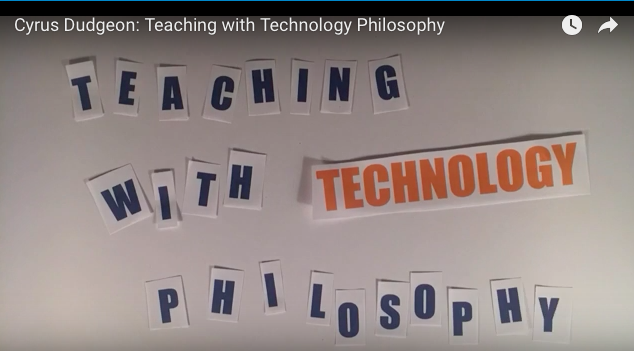Santa Fe Spotlight: Multimodal Writing in the Digital Age
0November 24, 2016 by Tom McKenna

 This past summer, we were always asking ourselves how we might critically incorporate technology into our teaching and why might we choose not to do so as well. What I was really impressed by was the level of creativity and willingness to experiment with technology that the members of our class engaged in while reflecting on pedagogical beliefs and how they might already include non-alphabetic writing practices. Both of the pieces by Cyrus Dudgeon and Claire Abisalih capture how these two educators, at very different schools, incorporate technology in meaningful ways to engage students with a wider range of resources for communication. I am especially excited to see both of these pieces included because of the important pedagogical purposes of nurturing creativity where there are fewer resources and advocating for social justice in spaces of privilege.
This past summer, we were always asking ourselves how we might critically incorporate technology into our teaching and why might we choose not to do so as well. What I was really impressed by was the level of creativity and willingness to experiment with technology that the members of our class engaged in while reflecting on pedagogical beliefs and how they might already include non-alphabetic writing practices. Both of the pieces by Cyrus Dudgeon and Claire Abisalih capture how these two educators, at very different schools, incorporate technology in meaningful ways to engage students with a wider range of resources for communication. I am especially excited to see both of these pieces included because of the important pedagogical purposes of nurturing creativity where there are fewer resources and advocating for social justice in spaces of privilege.
-Cruz Medina, Professor, Multimodal Writing: Literacy in a Digital Age
Summer 2016 at Bread Loaf Santa Fe
7090 Multimodal Writing: Literacy in a Digital Age
C. Medina/M, W 9-11:45This class asks how has new media literacy affected what makes ‘good’ writing in digital and online composing environments? And, once we understand new media literacy, how can we begin to take practical steps to implement multimodal practices in writing pedagogy? In Writing Studies, composing written communication no longer singularly refers to alphabetic texts and the ‘technology’ of the essay. Reflecting metacognitively on the writing process will bring to light what happens in the translation of alphabetic texts into the genres available in online writing environments such as blogs, instructional YouTube videos, and podcasts.We will examine research on relationships with technology to recognize how these writers negotiate the greater emphasis on digital writing. Then we will enter into research related to our own relationships with technology, focusing on issues with particular resonance to our thoughts and feelings about online and digital media, using multimodal writing to evidence this relationship.
Texts: Gunther Kress, Literacy in the New Media Age (Routledge); Jason Palmeri, Remixing Composition: A History of Multimodal Writing Pedagogy (Southern Illinois); Kristin L. Arola, Jennifer Sheppard, Cheryl E. Ball, Writer/Designer: A Guide to Making Multimodal Projects (Bedford/St. Martin’s).
Beyond Alphabetic Text
Cy rus Dudgeon
rus Dudgeon
Española High School
Española, NM
BLSE 2019 (anticipated)
This past summer at Bread Loaf, I took a course with Cruz Medina called Multimodal Writing in the Digital Age. Apart from exploring the pedagogical advantages of multimodal learning in the classroom, we were tasked with the job of creating our own teaching philosophy. This philosophy went through multiple remediations as we were challenged to learn and create in the very ways we were reading about. First, we composed in the medium of alphabetic text to communicate our philosophy; our texts were then revised to accommodate the form of an infographic; finally, we drew from both drafts to produce a video. I chose to use stop motion, primarily because I wanted to incorporate magic, which otherwise would have been challenging to work into something live action.
As my video communicates, the biggest take away from our work together with Cruz Medina is my newfound understanding of how moving beyond the medium of alphabetic text can be a means to creating and sustaining a learning space that places imagination at its center. I feel wary of the privilege commonly placed on alphabetic texts, and this in turn challenges me to open up the pathways along which students might engage and question their minds. Anecdotally, this year has felt more productive in terms of the learning I’m engaging in with my students: I feel my students are more likely to engage their minds, the texts, and each other when given different means to communicate and think.
Multimodal Writing: New Media, New Meaning, and Lasting Impact
 Claire Abisalih
Claire Abisalih
The Webb Schools
Claremont, CA
BLSE 2020 (anticipated)
I currently teach ninth grade and three upper level electives for juniors and seniors, including Honors Black Authors, Directors, and Laureates,”which I speak of in the following essay. In the spring I will teach American Crime & Punishment, focusing on a history of our criminal justice system and narratives of imprisonment. In my teaching, I prioritize concepts of social justice and identity within each of my classrooms. I encourage my students to find their own voices through a variety of texts and media. “Webb,” located in Claremont, CA is comprised of two schools, with a total enrollment of over 400 secondary students.
———
Ralph Ellison’s Invisible Man is one of my favorite novels to teach. As a piece of storytelling, it contains endless turns and escalations, compelling and intriguing characters, and, like the era and social-political movements the protagonist encounters, it seems to move at an ever-increasing pace. As a work of art, it is a poetic study in language, imagery, symbolism, allusion, and myriad other literary devices. As a political protest, it is in itself an act of powerful subversion (particularly for the time it was written) following in the model of W.E.B. Du Bois’s writings, using the linguistic conventions of the oppressor to tell the experience of the oppressed, and simultaneously navigating both audiences. As a historical artifact, as one student in my class this year said appreciatively, it’s a six-hundred-page lesson on the voices, people, and moments in America’s past you will find merely skimmed, if at all, in many middle- and high-school history text books.
Many of my students, before even cracking it open, though, approach it with a bit of skepticism. The sheer thickness of it is enough to intimidate a few, and in a traditional English classroom at a private boarding school, the fact that it is essentially about Blackness elicits much curiosity and, I’ve seen, a bit of fear and doubt in more than a couple kids. This fall, for the first time, I am teaching the novel within the context of a Black Literature elective, which changes the dynamic somewhat.
Like my students, I often find myself overwhelmed by the book. My insecurity as I approach it with a new group of eleventh and twelfth graders each year is not so much an uncertainty about where to begin the novel, but a fear that we can’t possibly get to everything by the time we finish it.
This summer at Bread Loaf Santa Fe, I was in the midst of planning my Black Literature elective for the fall semester. I knew Invisible Man would be our first and central text, and as I was moving unit-by-unit and day-by-day through planning the course, I was also working my way through Cruz Medina’s course, Multimodal Writing in the Digital Age. The course itself went beyond just how to teach multiple literacies and fluencies in our respective classrooms, but why that is so important.
In every course I teach, I seek to be a teacher of social justice and concepts of identity, recognizing that high school is a pivotal time when students are experiencing, exploring, and shaping their own sense of self and preparing to move into a globalized world full of wonderful diversity but also its accompanying tensions. Multimodal Writing emphasized the importance of preparing students for an uncertain future while embracing each student’s unique present and past. To do both of these things, Jason Palmeri advocates in Remixing Composition (with references to Paulo Friere and Geneva Smitherman) that we must “critically analyze and attempt to transform material hierarchies of class, gender, race, disability, and sexuality” within my classroom. In relation to Medina’s course and in the context of my own, this means not only subverting the traditional privileging of the printed word in my classes, but also encouraging students to choose and value the modes that best suit their (and others’) needs, histories, and identities.
When I had taught Invisible Man in the past, I had planned a final project that seemed to align with many of the methods and ideologies Multimodal Writing was describing. Students were given choice in their final project; they spent time drafting and editing along the way; they considered message and medium, themselves and their audience; and they were encouraged to create a finished project that veered off the beaten path of written essays and analysis. The assignment also helped students better understand the political and personal aspects of what Ellison endeavored to do with the novel. (Some of these projects are discussed and included on a blog I kept for our Multimodal Writing class.)
But I am still concerned with trying to tackle all that Ellison’s novel is and does. Recycling that final assignment would hit on the political angle, and as we’ve moved through the novel there have been no shortage of class discussions comparing the protagonist’s struggle to that of the Civil Rights movement or the current Black Lives Matter protests. But how to better guide students in understanding the historical significance and literary nuance of the text? Never a fan of lectures, I have been looking instead to “Multimodal Writing” to see how I might use different modalities to help students more deeply analyze and access the book. I looked at assessments and assignments not so much as ways to evaluate students, but as ways to challenge them—and also solve challenges we were facing as a class.
Within the first week or two of the course, I realized this particular class was, in general, fairly unfamiliar with the ideas of both Du Bois and Booker T. Washington. Understanding their ideologies, though, would be integral to students understanding Ellison. Instead of planning a lesson, I planned a project.
I didn’t want to assign a classic compare-and-contrast essay, though that might be the obvious choice. We had talked about how each writer—Ellison, Du Bois, and Washington—navigated audience awareness, tone, and “voice” in their writing, and it struck me I might ask students to use their own voice to convey their ideas to a very real audience of more than just one (the teacher). The protagonist of Invisible Man delivers multiple speeches throughout the novel. Although Ellison’s novel is written, it is (like Shakespeare) both a text-based and performance-based piece—written word that’s best spoken and heard.
I decided to challenge students to compose their comparison as a speech rather than an essay, so that they were not only analyzing the historical place the novel fit, but also experiencing the challenges tackled by Ellison as he wrote speeches into his own book. Along with experiencing this dimension of Ellison’s rhetorical challenge, they were being asked to—depending on their own skill sets—hone a talent they felt comfortable with, or learn an entirely new one. When I assigned the project, I heard sighs of relief (Thank goodness we don’t have to write another paper!) and sighs of frustration (Can’t I just write something without performing it?). Some students proposed embellishments to their speeches—a Prezi of images to accompany it, or adapting it into a “podcast” that could incorporate music and sound editing. The speeches they presented were creative and powerful, and in debriefing the project, students felt they had developed some new skills, a better understanding of history, and had seen first hand the added challenge of writing-to-speak instead of simply writing-to-read.
After that assignment, and as we moved into a particularly stressful time of year, participation in class lagged. Searching for a way to get students again more involved in the course and continuing to look deeply at Ellison’s language, I decided to adapt a close reading assignment. I had been inspired by the experience of being asked to lead lessons in both Bread Loaf courses I took in Santa Fe. Why not ask students to teach their own lesson and get their classmates engaging in their selected block of text? Being led by their classmates might inspire new perspectives on the book and new enthusiasm for participation. By looking specifically at how Ellison expresses his themes and ideas through language and style choices, they would also be engaging with his writing on that artistic level. We are now about halfway through these student-led classes centered on close reading passages, and again I am impressed with the activities students have planned, the effort they are putting in as teachers, the observations they’re making about Ellison’s writing and style, and the enthusiasm with which the rest of the class responds.
Prior to the Multimodal Writing course at Bread Loaf, I had thought of non-alphabetic texts as interesting and important, but not integral. I viewed assessments more as measurements of understanding, and less as answers to a challenge. If I am teaching concepts of social justice, identity, and diversity; if I am teaching critical thinking, connection-building, and thoughtful analysis; if I am preparing students for a technology-driven and globalized world–if all of that is true–then asking students to understand, incorporate, and produce multimodal texts is necessary. Beyond that, though, multimodal texts give us an opportunity to learn more than just a new skill, or answer a unique question, or strengthen their newfound understanding. These types of assignments can help students gain new perspectives, look more closely, and challenge their assumptions and routines. When students step outside their comfort zone, they are engaging with the text from a more vulnerable, personal, and hopefully more open-minded and creative place. A fresh personal investment shows during each assignment and stays with them long after it’s completed, just as Multimodal Writing has with me.
Category BLTN Teachers, Fall 2016, Featured | Tags:
Leave a Reply